Why the central lock 2110 does not work. Installation and repair of the central lock on a VAZ tenth model
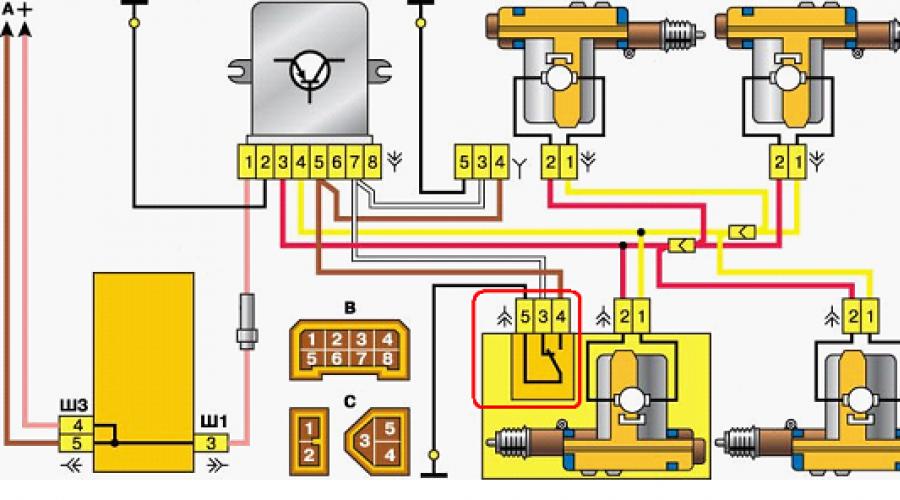
Read also
This review discusses how to connect an alarm system to the central locking of the following cars: VAZ-21099, as well as 2110 and 2115. There are three standard connection schemes: for central locking controlled by negative polarity, positive and variable. But for different cars there are some nuances. Sometimes it is necessary to add a fuse to the “+12 Volt” wire, sometimes, on the contrary, this is not required. VAZ locks, in turn, belong to the very simple type, to the first. But standard scheme, published on the Internet, is not suitable for them.
Features of the VAZ central lock
Everyone knows that the Lada models listed here use central locking controlled by negative polarity. This literally means the following: we apply “0 Volt” to one wire - all locks close. We apply the same voltage to the other wire (second) - they unlock. This is done in many European cars. What does it mean to “supply “0 Volt”? This means connecting the wire to ground.
Central locking control unit connector
The central locking control unit has the following wiring:
- Black wire – ground (connected all the time);
- Pink – power supply “+12V” (built-in fuse is used);
- Yellow, red - connected to the actuators in the doors (these wires are not connected to the signaling system!);
- Brown, white - control wires, just those that have already been mentioned.
Let's look at the central locking connection diagram, which is implemented “from the factory”:
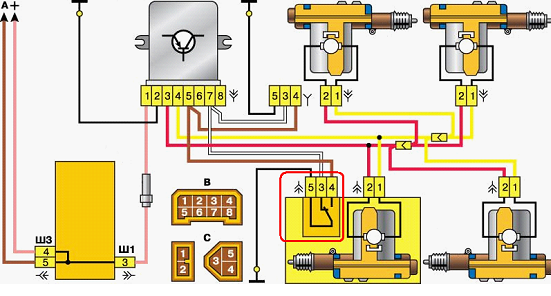 Standard connection diagram for central locking
Standard connection diagram for central locking First, we may decide that the triangular connector (labeled “C”) is suitable for our purposes, since it contains control contacts. But please note that the standard circuit uses a microswitch located in the driver's door. We will break two wires coming from this switch, and the relays built into the alarm unit will be connected to the breaks. Other options are excluded.
Let's make the alarm system and central locking together
Any block modern alarm system equipped with two relays connected to the central locking control unit. One relay is opening, the second is locking, and the circuit in the general case looks like this:
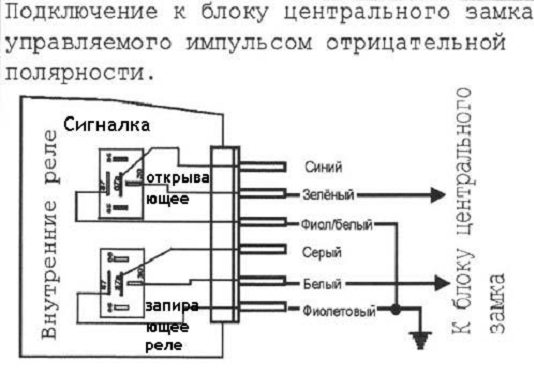 Control of central locking by supply of “mass”
Control of central locking by supply of “mass” In our case, the green and white cords coming from the signaling unit will be required, as indicated in the diagram. However, they will not be the only ones needed. We will connect the relay contacts to breaks in the standard wiring. This means there will be not 2, but 4 cords.
Connection diagram for VAZ central locker
Take another look at the diagram published in the first chapter. We will connect the relay to the gap in the white and brown wires going from the microswitch to the central lock control unit. And it is obvious that it is easier to break these wires near the 8-pin connector. The same one shown at the beginning.
To avoid any questions, we will show you what should happen as a result:
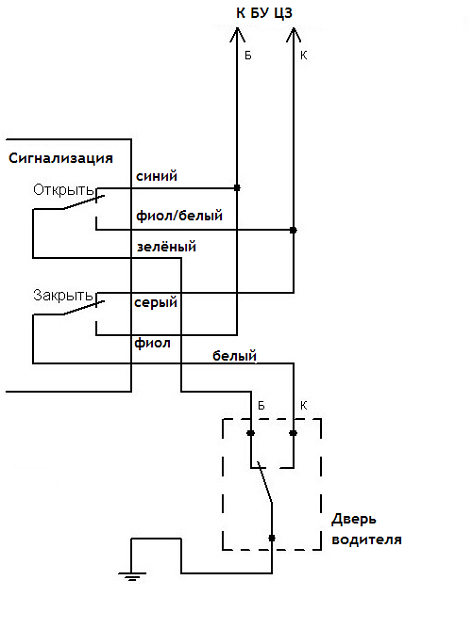 Connection diagram, central lock VAZ
Connection diagram, central lock VAZ
The common contacts are connected to the wires coming out of the microphone. The white cord continues with the brown wire coming from the door, and so on. Normally closed contacts are also used, along with normally open ones. These are the features of connecting to the VAZ central locking system.
An approximate sequence of actions performed by the installer:
- Make and lay a 4-core cable running from the signaling unit to the 8-pin connector;
- Connect the cable on the side of the alarm unit (see the last diagram);
- Near the 8-pin connector, disconnect the white and brown wires coming from the microswitch (pins 5 and 7). The main thing is not to confuse them with the wires going to the triangular connector “C”;
- Make connections to the broken wires, white and brown. That's all.
We have given this sequence to emphasize once again that the relays are switched on between the microphone and the central lock control unit. None additional devices no need to connect. As a result, the alarm system will be able to control the state of the locks.
Remember that installation is performed by removing the negative terminal from the battery.
All wires added to the car structure must be protected (use heat-resistant tubes or electrical tape). Twisting is not the worst method to connect two wires. But it's even better to use soldering.
It would seem that if a person has experience working with electrical equipment, he can do everything according to the instructions given. As a result, if no mistakes are made, you may encounter an interesting phenomenon. Instead of closing, there will be a short-term locking followed by opening. And vice versa. What to do in this case?
Take a look at what exactly may be present in some of the configurations:
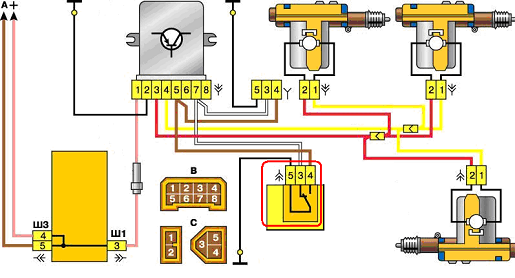 Cheaper - no driver actuator
Cheaper - no driver actuator The driver's door may not have an actuator. And then, it is useless to connect the signaling system to the control unit. There is no actuator, which means there is no one to close or open the door and move the microphone lever. Let's say the locks are closed, and then we remove ground from the brown wire and we get the following: the white wire is on ground, unlocking occurs.
We note the following: installation can only be carried out when you are sure that there is an actuator in the driver's door.
There were configurations where only a microswitch was installed. There is no need for arrogance here - adding an actuator will be difficult, since standard wiring must go to it. As you understand, it may not be available from the factory. And it’s unclear what to do then.
There remains one unanswered question - where exactly the central locking control unit is located. In these VAZ models, if there is a central locking system, then there is also a control unit. And it is located under the torpedo cover, next to the driver, on the right:
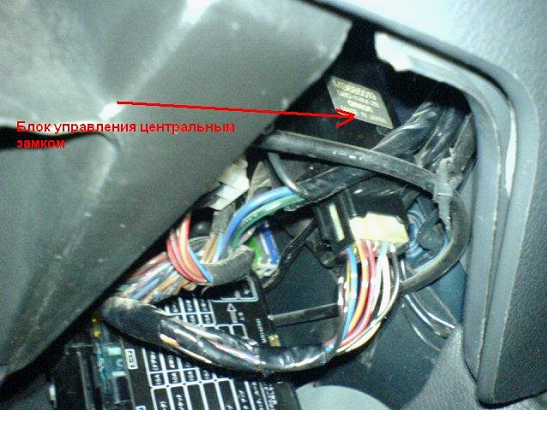 VAZ-2110, BU TsZ
VAZ-2110, BU TsZ We remove the “beard” of the torpedo and look at what is on the upper right. On the same plane with the radio connector there are two boxes attached - the one we need, as well as the immobilizer (if there is one).
We would be lying if we did not say that in reality there is another option for installing the alarm. Standardly, only two are used for actuators power cables. Having a power outlet equipped with a fuse, these cables are connected directly to the signaling relay. This option, as you might guess, is not recommended. Imagine what would happen if the alarm system broke. The central lock should remain, but in in this case this will not be completed. Happy connection!
Installation of the VAZ-2110 lock actuator
You quickly get used to good things and when breaks down central locking , then there is no need to delay repairs. The cause of the breakdown can be determined by the symptoms and in most cases repair the central lock with your own hands is not difficult. However, in some cases solve the problem of central lock The only way is to replace it.
How install central locking in VAZ 2110 I won't tell you, because... detailed instructions is in the VAZ 2110 documentation (connection diagram for the VAZ 2110 central lock), but I’ll try show clearly various breakdowns electric lock and ways to solve them.
Central locking (CL) or another way electronic lock consists of an activator (actuator, electric door lock drive), wiring, traction. Therefore, if you have The electric lock is broken and not working, then the problem lies in these components.
The VAZ 2110 can use various activators. They may differ in force, small design features, manufacturer/country, etc., but their operating principle is similar: 
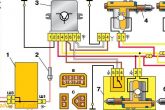
![]()
Operating principle of the central locking activator
In order to understand why doesn't the electric lock work?, you should consider the principle of its operation:
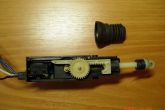 |
Five-wire activator with cover removed. There is a boot above the activator. Two activator wires are connected to the electric motor. The remaining three wires are connected to the limit switch. |
 |
In this photograph, the fragment with the image of the limit switch is enlarged, it is indicated by the letter “A”. “B”—stem shank in extended position. “C” is the motor shaft with a gear mounted on it. |
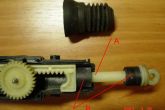 |
“A” - the rod is extended. “B” - damper rubber rings. They protect the rod and body from damage when impacted in the extreme positions of the rod. |
It is not correct to check the operation of the activator without rigid fixation (without mounting on the door) and without connecting the rod, because
after being triggered to the extreme retracted or extended position, the rod will rebound in the opposite direction.
Power steering VAZ Here you will find any auto parts for Favorable Prices for Your Car!avtobazar.ua
Problems with the central locking
Consider the moment when the driver closes the car, the doors close and immediately open.
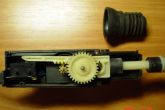 |
If we consider this case in detail, it turns out that the rod is retracted almost completely, and the limit switch is in a borderline state (it may be pressed, or it may not). The limit switch will send a command to the central locking module and the other doors will also close, but as a result of minor deformation of the door or mechanism (for example, a small impact on the car, heating/cooling of the door metal, etc.) the limit switch can switch back and the central lock will open. The defect may appear when the door is closed, when the standard mechanism springs the rod and, accordingly, the rod into the reverse position and the doors open again. |
To make sure that this is the problem with the central locking in your case, you need to turn on the alarm while sitting in the car and try to press the door lock button down with your hand (to prevent a spring defect in the mechanism). If the doors do not open, then this means the above-described defect in the mechanism for adjusting and fastening the activator and its rod.
Why is there no such problem with central locking on foreign cars?
Because there the command to open the lock is given by other circuits that do not receive a signal confirming the position of the rod.
If the central locking only works in one direction, and in the other not, but when an attempt to move occurs, then perhaps the reason is poor fastening of the screw on the activator rod.
The problem is when When closing/opening the central lock there is a rattling noise and the rod does not move.
It's all about the plastic parts. The intermediate gear transmits rotation from the gear on the motor shaft to the teeth of the rod. Because The gear is plastic, and over time the teeth will chip and break. 
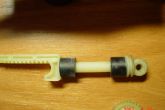
This failure of the central locking system is often found in Alpha activators. The pin on which the intermediate gear is mounted breaks the mounting hole, or this hole may be larger than necessary. Hence the skew of the gear, jamming of the activator, and a similar cracking of the teeth from their loose fit.
Also all other plastic elements of the activator over time and from not correct installation the central lock may break.
Activator motor has a brass gear, which over time will break down the plastic of the gear, and the gear on the shaft will simply spin. 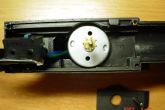
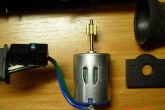
The problem is when The central locking does not work, but the rod can move as usual, by hand. Or central lockingdoes not always work (every time). In this case, the central locking motor failed. The activator motor is disassembled, where “A” is the commutator pole with a winding soldered to it, “B” is the commutator poles, and “C” is the commutator brushes. 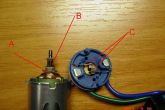
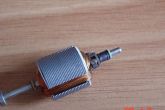
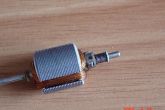
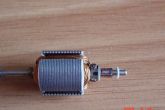
The central locking motor may not work for a number of reasons:
Car headlights and optics Headlights for cars with delivery throughout Ukraine. Original and analogues. Address and phone number aksmir.com.ua
Correct installation of the central locking (activator)
Incorrect installation of the activator in the car door increases wear of parts, that leads to breakdown of the central lock.
Install activator can be done as desired (vertically, horizontally or at an angle), just as the closure can be by extending the rod or vice versa.
It is important that there is enough space for the activator to work, there is enough space for the traction to pass through, it is also comfortable and reliable connection traction, accessibility of fastening.
Check the operation of the central locking should be done with the windows lowered and after installing the door trim.  Activator mount should be at maximum flat surface. Slight distortion when fastening to uneven surface with the force of the screws can cause difficulty in the operation of the gear shafts. When installing the activator, it is recommended to use washers or bushings to level the surface. If the activator gets into holes in the metal of the door, then it is necessary to use the plate from the activator kit.
Activator mount should be at maximum flat surface. Slight distortion when fastening to uneven surface with the force of the screws can cause difficulty in the operation of the gear shafts. When installing the activator, it is recommended to use washers or bushings to level the surface. If the activator gets into holes in the metal of the door, then it is necessary to use the plate from the activator kit.
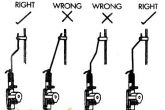 The design of the VAZ 2110 door implies bending rod, so it is important to bend the rod correctly. The angle should be clear and preferably minimal. If the angle approaches the arc or the distance of the activator attachment from the rod itself is very large, then instead of the effort of moving the standard rod we will get a force to overcome the bend of this arch. It is clearly visible in the second figure, where the activator, pushing the rod upward, will apply force to the standard rod not upward, but to the side.
The design of the VAZ 2110 door implies bending rod, so it is important to bend the rod correctly. The angle should be clear and preferably minimal. If the angle approaches the arc or the distance of the activator attachment from the rod itself is very large, then instead of the effort of moving the standard rod we will get a force to overcome the bend of this arch. It is clearly visible in the second figure, where the activator, pushing the rod upward, will apply force to the standard rod not upward, but to the side.
If the central locking does not work correctly and the activator does not always have enough power to open or close the door, you should focus your efforts on finding the cause and eliminating the malfunction. However, enthusiasts have found another solution to this problem - modified central locking VAZ 2110(installed the second activator). That is, the second activator is additional and helps the work of the first standard activator. The yellow arrow is the direction of movement of the rod of the standard mechanism, and the red arrow is the movement of the additional activator. 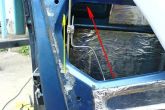
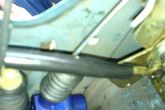
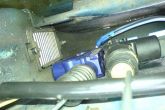
In fact If the activator is installed correctly, no additional activator is required and one activator can do its job perfectly.
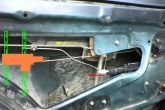 An example of incorrect installation of the central lock. The yellow arrow is the movement of the standard rod, the red arrow is the movement of the activator rod. As a result, the force of the rod will be applied to the fracture and the steel rod will eventually begin to pop out of the rod hole. The error can be eliminated by installing plates ( green color) under the activator (orange). Thus, the activator will be as close as possible to the standard rod and bends in the activator rod will be minimal.
An example of incorrect installation of the central lock. The yellow arrow is the movement of the standard rod, the red arrow is the movement of the activator rod. As a result, the force of the rod will be applied to the fracture and the steel rod will eventually begin to pop out of the rod hole. The error can be eliminated by installing plates ( green color) under the activator (orange). Thus, the activator will be as close as possible to the standard rod and bends in the activator rod will be minimal.
Correct fastening of the lock rod 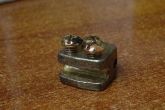 Rod fastening element has a through hole for the activator rod and a split side for attachment to the standard rod. If the fixing screws are loosened, then this element should move freely on the activator rod. We select the mounting location and fix the screws with proper force. Push the activator rod down by hand, then push the standard rod in the direction corresponding to the closed state of the door lock.
Rod fastening element has a through hole for the activator rod and a split side for attachment to the standard rod. If the fixing screws are loosened, then this element should move freely on the activator rod. We select the mounting location and fix the screws with proper force. Push the activator rod down by hand, then push the standard rod in the direction corresponding to the closed state of the door lock.
After both rods are retracted, we fix the screw on the activator rod with medium force. Holding the standard rod in place, we extend the activator rod together with the fastening by 2-3 mm and fix the fastening with medium force on the standard rod of the lock.
Checking work: We check with our hands the movement of the activator together with the door lock mechanism; the latch must be closed. We check the opening of the latch in the extreme positions of the activator. We check in what positions the remaining doors close. The main thing is that this is not one of the extreme positions or close to the extreme position of the additional activator. We check the movement of the window lifter. We apply the door trim to ensure subsequent fastening and the absence of protruding elements. If everything is fine, tighten the screws securing the rods with maximum force.
We check the operation of the activator by hand again. We check the operation of the activator from the battery. We briefly touch the long wires from the battery to the activator wires, change the polarity and operation of the activator in a different direction.
A number of deviations, amendments and wishes:
 If fastening screw No. 2 on the rod becomes loose, then there may be several options:
If fastening screw No. 2 on the rod becomes loose, then there may be several options:
The rod slides in the hole and the lock does not move.
The lock either closes or opens. This happens because the sharp edges of the element (at points 1) can bite the rod and, depending on the upper or lower point, will either only close or, on the contrary, open.
Installing the activator on cable traction
Actually, the installation is similar to that described above, but the attachment to the locking mechanism cables is shown in the photo.
Fig2: Fastening the kit to the metal of the door and fastening the cable in the jacket
Fig3: The cable is released from the jacket between the fastenings.
Fig4: Connecting the activator rod to the cable. 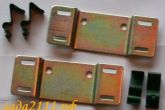

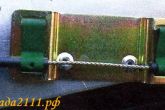
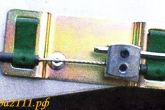
This kit is hard to find on sale, so the plate can be cut out of metal yourself, and the spring fastenings can be taken from the Gazelle stove (fastening the cable jacket). Activator.
Conclusion
Causes of central locking failure many, some of them are related to climatic conditions (cold winters, high humidity etc.), and partly due to incorrect installation or adjustment of the central locking. In any case, from the symptoms you can understand where approximately or exactly problem with the electric lock.
By the way, do you know how to install additional. central locking button?
Cars produced in the 21st century are very technologically advanced and safety-conscious. They include many devices for the protection and comfort of the car owner. The domestic auto industry is trying to keep up to the best of its ability - this is how a central lock appeared in the VAZ 2109 and 2110.
Additional option – is it worth ordering?
The presence of a central lock in a VAZ car is considered an additional option, and only if we talk about cars manufactured after 2000. However, in VAZ 2109 models deprived of this advantage, it is not difficult to install it.
The main purpose of the VAZ 2109 central lock is to automatically open and close all car doors simultaneously. The central locking can be controlled using an alarm remote control that interacts with the system, as well as using a key. The central locking mechanism consists of several sensors located in the door envelopes, and circuit breakers. This entire system is interconnected and looped into the vehicle's power supply.
Installing a central lock - car upgrade
If you are interested in such a device, you can install it yourself at home. You can buy central locking for the VAZ 2109 at almost any auto store. They are the same type of design, so the lock from other VAZ cars will also work. For installation, in addition to the lock, you will need several screwdrivers and keys, as well as desire and patience.
Before starting work, you need to disconnect the terminals from the car battery, since installing the lock requires connecting the power supply. After this, you can begin to remove the cards with the casing. During the removal process, the latches that hold them in place may break, so prepare new ones in advance.
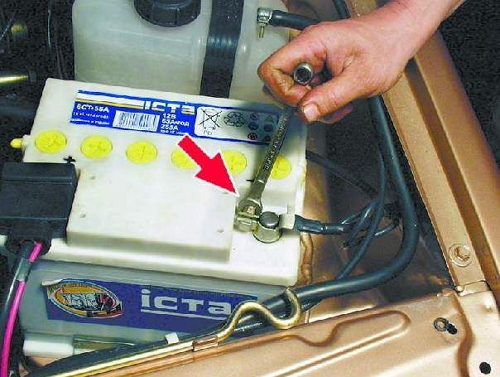
Next you need to choose the right place for. It is worth considering the peculiarity of moving the glass mechanism. In rare cases, you may need to purchase additional mounts for the car envelope. The central lock is attached to self-tapping screws and bolts with nuts. Basically, the factory provides a place for installing a lock, and there are also special electrical chips for connecting it.
If there are no such chips in the envelope of your VAZ 2109, then you will need to extend the wiring to the on-board computer control unit. It is located inside the car under the stove shaft. Connecting the power supply correctly will not be difficult for you, because all the chips are universal. A similar installation procedure must be done with the rest of the car cards. Wiring from locks rear doors It’s best to let it go over the thresholds of the car.
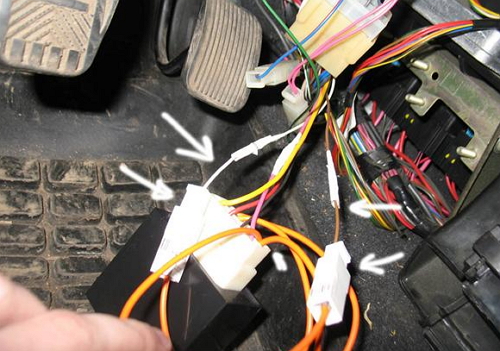
After installing the central locking mechanism, make sure that all doors operate correctly. It is very important that the lock bars move freely and do not interfere with the opening of the main lock handle, as well as the lowering of the car window. During installation everything metal connections needs to be lubricated. And only after that proceed to reassembling the cards with the casing.
Central locking breakdown - we repair it ourselves!
Quite often it happens that the system fails to work - if you are the owner of a domestic car, you are no stranger to breakdowns. This may be a partial breakdown, which in some cases requires cleaning the mechanism from dust or more accurately aligning the lock mounting rods, or minor failures in the power supply system. Sometimes a complete failure of the entire device occurs, which requires replacement of some elements of the mechanism.
Often, central locking sensors fail and are easy to replace. Since the lock is directly connected to the car alarm, in our case it is necessary to start the check with it. Try opening and closing the driver's door lock with the key. If the central locking system works, then the problem is with the alarm. If there is no alarm in your car, then proceed immediately to checking the entire lock system.
The main cause of failure in the central locking mechanism is a device called the activator.

It is installed in the front doors of the car. Its main action is to send an electrical signal to the remaining doors to open or close them. When the activators are triggered, the signal is sent to the central board, which contains fuses. Although they fail quite rarely, they also need to be checked.
Additional fuses are located in the car envelope itself, near each mechanism with a rod. If the lock does not work on exactly one door, then the problem is located there. To fix it you will need a new fuse and a set of tools. Very often, VAZ 2109 owners come to a different solution and connect the wires directly, but this is not recommended, because in the future the entire central locking system may completely fail.
The central locking mechanism is designed in such a way that if the activator in the driver's door envelope breaks down, the rest will also not work. If you have a problem with the button manual opening doors, then look for the reasons for the violation of the fixation of the activator rod.
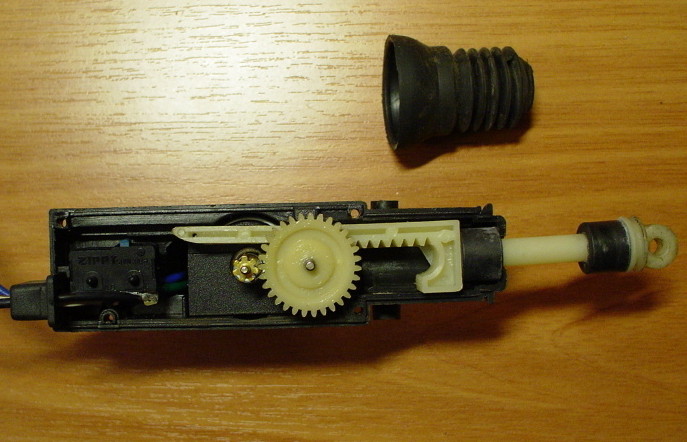
When connected electrical circuit It is best to make the VAZ 2110 work when you turn the key in the ignition. This will keep you safe while traveling. To make this type of connection, you must carefully read the installation instructions. If necessary, you should call an electrician for help or carry out the installation at a specialized car service center.
Central locking is a system of devices designed to unlock or lock car doors. Typically, unlocking and locking occurs using remote control, which, in addition to locking the doors, has a trunk opening function.
In addition, if the remote control stops working, you can insert the key into the lock cylinder and turn it clockwise. After this action, when one door is locked, all the others will close, making the driver’s work easier.
If for some reason the car gets into an accident, the locks will automatically open, thereby making it easier to leave the car and create access for rescuers into the cabin.
Scheme and principle of operation of the central lock
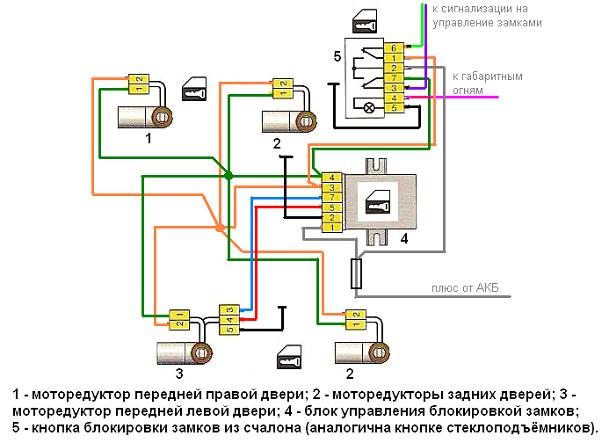
The central locking system has special sensors that form the basis of the locking system. They consist of very small switches and limit switches, as well as actuators and a main control unit. Limit switches are designed to hold the door and further transmit information to the control unit. Switches control the position of the part that must lock the lock.
The front doors are locked using cam devices, which are controlled by two switches. The first is for opening the door, the second is for locking.
A similar system is used for the rear doors, however, there is also a fifth switch. It closes at open door and turns off the central locking.
The control unit receives information from the remote control and door switches, processes it and sends a signal for execution to the switches, which subsequently close the lock control drive circuits.
Video - Causes of VAZ central locking malfunction
Like any equipment, the central lock can fail. Most often, drivers themselves have a detrimental effect on the central locking of the car. An example of this would be long pressing a remote control button. After all, when the locking or unlocking circuit is closed, the electric motor is activated, the collector of which heats up greatly and disables the entire activator drive. The door, however, does not respond in any way to pressing the remote control buttons. This malfunction can be eliminated by replacing the activator with a new one.
If the entire lock suddenly loses power, then troubleshooting begins with the fuse. Its location can vary from the fuse box to the floor of the car. In the case of the floor, if it is located under the rug, then the cause of its burnout may be moisture that accumulates during the operation of the car in winter, spring and when using linoleum as floor covering. In this case, the cause of the malfunction is eliminated and the fuse should be replaced.
Besides electrical faults, there are also mechanical problems with the central locking system. These include breakdowns of the gears of the entire modular locking drive unit and wear of the solenoid. Modular block needs to be completely replaced, but you can get by with simply replacing the gear. The solenoid, in turn, also needs to be replaced, since its resource is usually enough for 10 thousand closing and opening operations.
Breakdowns of mechanical parts can also occur due to lack of lubrication in moving parts. Therefore, it is recommended to periodically check the condition of metal parts and the presence of lubricant on them.
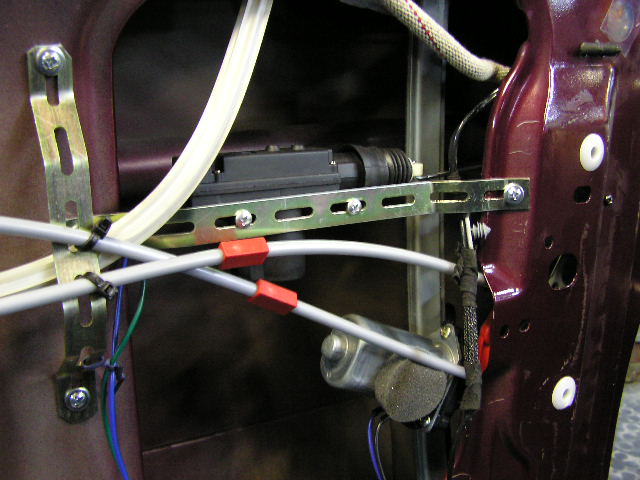
Before starting installation, you must remove the battery terminal, dismantle the door trim and select a location for installation. It is worth considering that the mechanism for moving glass has its own characteristics. Therefore, before installing the lock in the chosen location, make sure that both mechanisms will not interfere with each other. Typically, the factory provides special places for attaching such locks, and in exceptional cases, also electrical components that are already fixed in place. Fastening of additionally purchased elements is carried out using self-tapping screws and bolts with nuts.
The wiring must be pulled to the on-board computer control unit. You can find it right under the stove shaft in the car's interior. Since there are certain standards for connecting central locks, it will not be difficult for you to connect all the wiring correctly. In addition, such elements are usually accompanied by electrical circuits. It is recommended to route the wiring of the rear door locks along the thresholds of the car.
After connecting all the elements, you need to check the locking process. Close all doors and remain inside the vehicle. Press the lock button on the remote and make sure all doors are locked. Try lowering your vehicle windows. If the windows go down without any problems, and this does not in any way affect the performance of the central locking, then this means that the lock is installed correctly. Lastly, check whether the lock drive rods do not interfere with opening the door using standard handles.
If all elements work correctly, then the lock installation was successful. All metal parts of the central locking system must be lubricated, and only after this is it possible to install door trim cards.
This is, perhaps, all you need to know about installing the VAZ 2110 central lock. However, do not forget that you can install the lock not only on your own, but also contact any station for help Maintenance cars, where they can handle this work without difficulty and do it efficiently.
VAZ-2110 is additional option, is not included in every vehicle configuration. In fact, the mechanism is quite cheap, easy to install, repair and use, but at the slightest breakdown the car owner faces difficulties. It is not very convenient to check whether the lock flags are lowered before each exit from the car. It is much easier to close all the locks by pressing one button on the alarm remote control or turning the key in the driver's door cylinder.
Central locking on cars of the tenth family
The main function of the device is clear from the name: it is used to unlock and lock all car door locks at the same time. The operation of this device can be carried out both in conjunction with a car alarm and without it. The basis of the device is the VAZ-2110 central locking unit, which is a small circuit containing several semiconductor elements and electromagnetic relays. Instead of the latter, not relays, but transistor power switches can be used.
Despite all the advantages of central lock control, you should not trust it completely, especially if certain sins have been observed. In case of minor failures, one or more locks may not close completely. The reason for this may be a malfunction of the electric motor, the gearbox included in its composition, or the control system. For carrying out even small repair work You need to know the structure and operating principle of the central lock.
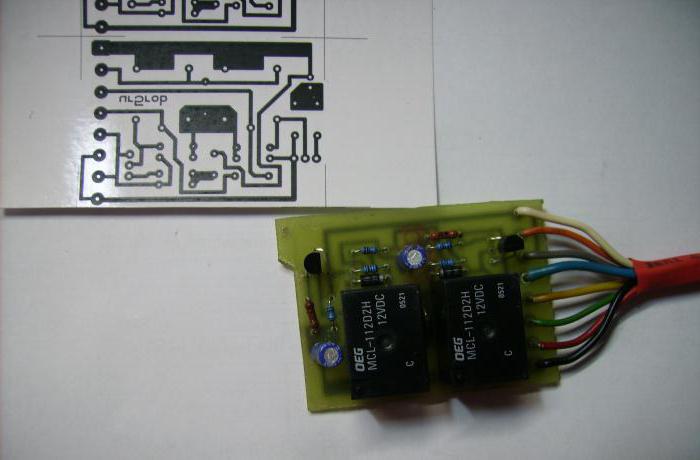
Main Components
The central lock (VAZ-2110) has the following components in its design:
- Semiconductor control unit for electric drives.
- The actuators are geared motors (4 in total - one for each lock, but if there is a drive to unlock the trunk, then five). These are small electric motors with gearboxes on the rotors.
- allowing you to determine the condition of the lock (installed in the gearmotor mounted in the driver's door).
- Wires, connections, fuse.
The VAZ-2110 central lock can operate in several modes:
- All locks are activated when the driver's door is unlocked/locked.
- When arming and disarming a car alarm. Provided that the alarm and central locking control units have been connected.
- If available remote control Central locking from the key fob. Such control systems have quite low cost and can be used on cars without alarms.
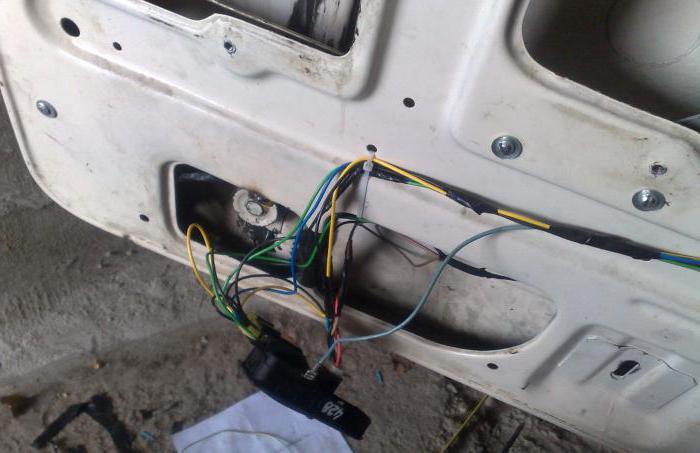
The main causes of central locking failures
If the VAZ-2110 central locking does not work, the reason for this is some defect in the actuators - gear motors. In the entire structure, they are the most vulnerable point, since they are subject to the greatest load. These devices move during operation, which speeds up the production of the elements included in their design.
But there is one important detail - VAZ-2110 cars were discontinued more than ten years ago, which already suggests that any of the cars will have problems associated with the “obsolescence” of elements. Wiring is destroyed, gearmotors become unusable, even transistors in the control unit due to frequent overheating may fail during such a period. Therefore, it is necessary to carefully study all the symptoms of breakdowns and methods for eliminating them.
Central locking activators
It is with their help that the VAZ-2110 central lock is controlled. They are mounted in the doors and have a plastic body. Incidents of meltdown are rare, but they do happen. Especially if the device is subject to a large load or the motor is frequently triggered. In case of a physical defect (melting, destruction), the following symptoms appear:
- On the door in which the defective activator is located, the unlocking/locking function stops working.
- The fuse fails due to excessive loads on the supply circuit.
Causes of activator failures

Almost all activator components are made of plastic. It is quite durable and can withstand heavy loads. But there are also defects and lock malfunctions. In the latter case, there is a sharp increase in the load on the motor, the gears can break down and become disengaged. The lock will buzz, but the flags will not go down (or up, depending on the current state).
But such a manifestation of breakdowns can also be caused by incorrect installation. This is only the case if work has taken place relatively recently, directly or indirectly affecting the elements of the central lock. Failure to adjust the rods is the first sign that the entire system will not work correctly. The lock on which the adjustment is incorrect will not work, while the others function properly.

central locking
Every motorist who has at least once encountered it knows where the central locking (VAZ-2110) is located. It is located under the central part of the dashboard, right on the floor. It is quite simple to distinguish it: the block is made of plastic, a wiring harness with a block at the end fits into it. Having removed the cover from the block, you will see a small board inside it. It is this block that is responsible for the functioning of the entire system. And the reasons for its failure may be the following:
- When the activators malfunction or the load on them increases, the current in the power circuit increases. This leads to significant overloads, fuse failure, and destruction of printed wiring tracks. Under prolonged thermal loads, the soldering is destroyed, the mounting legs of the elements lose electrical contact with the whole scheme.
- Age plays a big role, so over time the contacts in electromagnetic relays can break down. Transistors do not last forever; they can also fail if overloaded.
- If the fuse burns out, the entire circuit does not work - the central locking does not respond to anything. The fuse is located in a special rubberized or plastic case, in a break in the red (sometimes pink) wire. Please note that you cannot install fuses of a larger rating, as this will lead to melting of the wiring and a fire.
- The plug connection of the control unit is one of the most vulnerable points. Next to him is the stove (heat source), and the driver’s shoes, which may have dust, dirt, and water on them. All this together causes oxidation to appear on the block. You can get rid of it using special solutions or sprays (WD-40 and the like). If the condition of the pad leaves much to be desired, it is easier to replace it completely.

Control unit electronics
The VAZ-2110 central locking circuit consists of semiconductors and electromagnetic relays. But the latter are not used in all central locking models. After all, it is much more efficient to use transistor switches; they work on the principle of a relay, but there is no physical stress. As a result, mechanical wear is completely excluded. But there is still a chance of breakdown of semiconductor elements.
If there is a breakdown, the central locking system on the top ten will either be constantly set in motion, or will completely stop responding to action. To check the operation of the control unit, it is necessary to connect alternately to the yellow and red wires of the driver's door gearmotor. Preferably directly on the connection block to the control unit. If the flags go up and down normally, then there is no point in blaming the electronics for failure; you need to look for the cause in other components.

Breakdowns in the wiring
Next important element The entire system is electrical wiring. The operation of the central lock depends on its condition. If there are abrasions on the wires or cuts, this will inevitably lead to either spontaneous activation of the activators or to their inoperability. Most often, the wiring is destroyed at the bends - between the door and the body. To check the integrity, you need to test each wire separately. Just remember to turn off the power, otherwise you will damage the multimeter.
Limit switch malfunctions
The limit switch allows the control system to understand in what position (locked or unlocked) the this moment time door. With its help, a signal is sent to unlock and lock the VAZ-2110 central locking relay. In the event of destruction, a picture may be observed in which a signal to unlock is received, but a signal to lock is absent. To make repairs, you need to completely change the driver's door activator. These elements cannot be repaired, so in case of breakdowns, only complete replacement will help.